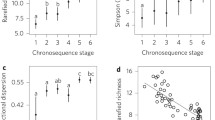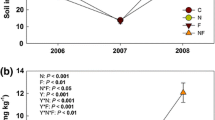Abstract
Water balance influences soil development, and consequently plant communities, by driving weathering of soil minerals and leaching of plant nutrients from the soil. Along gradients in water balance, soils exhibit process domains where chemical properties are relatively stable punctuated by pedogenic thresholds where soil chemical properties change rapidly with little additional change in water balance. We ask if plant macronutrient concentrations in leaves also exhibit non-linear trends along water balance gradients, and if so, how these non-linearities relate to those in soils. We analyze foliar nutrient concentrations and foliar N:P ratios from eight species that span a range of growth forms along three water balance gradients (three of the species are found on multiple gradients). The gradients are located on basaltic substrate of different ages and have previously been characterized by studies on soil development. We find that maximum concentrations of foliar macronutrients occur at an intermediate water balance. As with soil nutrients, time mediates the effect of water balance on foliar nutrients, such that plants on older soils attain maximum nutrient concentrations at a lower water balance. On both a young, 20 ky and an old, 4100 ky water balance gradient, foliar nutrients reach peak concentrations at a water balance greater than the threshold for depletion of rock-derived nutrients in surface soils. Our findings suggest that plant acquisition of essential nutrients is imperfectly predicted by overall soil nutrient availability because the regulation of internal nutrient pools by plants makes nutrient pools within leaves partially independent of soil nutrient availability.
Similar content being viewed by others
Availability of data and materials
The datasets used and/or analyzed during the current study are available from the corresponding author on reasonable request.
Code availability
The code used for this study is available from the corresponding author on reasonable request.
References
Aerts R, Chapin FS (2000) The mineral nutrition of wild plants revisited: a re-evaluation of processes and patterns. Adv Ecol Res 30:1–67
Alvarez-Clare S, Mack MC (2011) Influence of precipitation on soil and foliar nutrients across nine Costa Rican forests. Biotropica 43:433–441
Austin AT, Sala OE (2002) Carbon and nitrogen dynamics across a natural precipitation gradient in Patagonia, Argentina. J Veg Sci 13:351–360
Bateman JB (2017) Climatic, temporal, and biotic controls on soil biogeochemistry in intermediate aged volcanic soils, Doctoral Thesis, Stanford University
Bateman JB, Chadwick OA, Vitousek PM (2019) Quantitative analysis of pedogenic thresholds and domains in volcanic soils. Ecosystems 22:1633–1649
Bloom AJ, Chapin FS, Mooney HA (1985) Resource limitation in plants—an economic analogy. Ann Rev Ecol Syst 16:363–392. https://doi.org/10.1146/annurev.es.16.110185.002051
Burnett MW, Bobbett AE, Brendel CE, Marshall K, von Sperber C, Paulus EL, Vitousek PM (2022) Foliar ẟ15N patterns in legumes and non-N fixers across a climate gradient, Hawaiʻi Island, USA. Oecologia 198:229–242
Burnham KP, Anderson DR (2004) Multimodel inference: understanding AIC and BIC in model selection. Sociol Methods Res 33:261–304
Chadwick O, Derry L, Vitousek P, Huebert B, Hedin L (1999) Changing sources of nutrients during four million years of ecosystem development. Nature 397:491–497. https://doi.org/10.1038/17276
Chadwick OA, Chorover J (2001) The chemistry of pedogenic thresholds. Geoderma 100:321–353. https://doi.org/10.1016/S0016-7061(01)00027-1
Chadwick OA, Gavenda RT, Kelly EF, Ziegler K, Olson CG, Elliott WC, Hendricks DM (2003) The impact of climate on the biogeochemical functioning of volcanic soils. Chem Geol 202:195–223. https://doi.org/10.1016/j.chemgeo.2002.09.001
Crews TE, Kitayama K, Fownes JH, Riley RH, Darrell A, Mueller-Dombois D, Vitousek PM (1995) Changes in soil phosphorus fractions and ecosystem dynamics across a long chronosequence in Hawaii. Ecology 76:1407–1424
Cunningham SA, Summerhayes B, Westoby M (1999) Evolutionary divergences in leaf structure and chemistry, comparing rainfall and soil nutrient gradients. Ecol Monogr 69:569–588
Elser JJ, Bracken MES, Cleland EE, Gruner DS, Harpole WS, Hillebrand H, Ngai JT et al (2007) Global analysis of nitrogen and phosphorus limitation of primary producers in freshwater, marine and terrestrial ecosystems. Ecol Lett 10:1135–1142. https://doi.org/10.1111/j.1461-0248.2007.01113.x
Fajardo A, Siefert A (2018) Intraspecific trait variation and the leaf economics spectrum across resource gradients and levels of organization. Ecology 99:1024–1030
Giambelluca TW, Nullet D (1991) Influence of the trade-wind inversion on the climate of a leeward mountain slope in Hawaii. Clim Res 1:207–216
Giambelluca TW, Shuai X, Barnes ML, Alliss RJ, Longman RJ, Miura T, Chen Q et al. (2014) Evapotranspiration of Hawai‘i. Final report submitted to the U.S. Army Corps of Engineers—Honolulu District, and the Commission on Water Resource Management, State of Hawai‘i.
Harpole WS, Ngai JT, Cleland EE, Seabloom EW, Borer ET, Bracken ME, Elser JJ et al (2011) Nutrient co-limitation of primary producer communities. Ecol Lett 14:852–862. https://doi.org/10.1111/j.1461-0248.2011.01651.x
Herbert DA, Fownes JH (1995) Phosphorus limitation of forest leaf area and net primary production on a highly weathered soil. Biogeochemistry 29:223–235
Huston MA (2012) Precipitation, soils, NPP, and biodiversity: resurrection of Albrecht’s curve. Ecol Monogr 82:277–296
Jenny H (1980) The soil resource: origin and behavior. Springer, New York
Jobbagy EG, Jackson RB (2001) The distribution of soil nutrients with depth: global patterns and the imprint of plants. Biogeochemistry 53:51–77
Jobbagy EG, Jackson RB (2004) The uplift of soil nutrients by plants: biogeochemical consequences across scales. Ecology 85:2380–2389
Koerselman W, Meuleman AFM (1996) The vegetation N: P ratio: a new tool to detect the nature of nutrient limitation. J Appl Ecol 33:1441–1450. https://doi.org/10.2307/2404783
Lincoln N, Chadwick O, Vitousek P (2014) Indicators of soil fertility and opportunities for precontact agriculture in Kona, Hawai’i. Ecosphere 5:1–20
Luo W, Elser JJ, Lü XT, Wang Z, Bai E, Yan C, Wang C et al (2015) Plant nutrients do not covary with soil nutrients under changing climatic conditions. Glob Biogeochem Cycles 29:1298–1308. https://doi.org/10.1002/2015gb005089
Marshall K, Koseff C, Roberts AL, Lindsey A, Kagawa-Viviani AK, Lincoln NK, Vitousek PM (2017) Restoring people and productivity to Puanui: challenges and opportunities in the restoration of an intensive rain-fed Hawaiian field system. Ecol Soc. https://doi.org/10.5751/ES-09170-220223
Menge DNL, Hedin LO, Pacala SW (2012) Nitrogen and phosphorus limitation over long-term ecosystem development in terrestrial ecosystems. PLoS ONE 7:e42045
Menge DNL, Pacala SW, Hedin LO (2009) Emergence and maintenance of nutrient limitation over multiple timescales in terrestrial ecosystems. Am Nat 173:164–175
Mitchell HL, Chandler RF (1939) The nitrogen nutrition and growth of certain deciduous trees of Northeastern United States. Black Rock For Bull 11:1–94
Muggeo VMR (2003) Estimating regression models with unknown break-points. Stat Med 22:3055–3071
Perakis SS, Hedin LO (2002) Nitrogen loss from unpolluted South American forests mainly via dissolved organic compounds. Nature 415:416–419
R Core Team (2020) R: A language and environment for statsitcal computing. R Foundation for Statistical Computing, Vienna
Rasmussen C, Dahlgren RA, Southard RJ (2010) Basalt weathering and pedogenesis across an environmental gradient in the southern Cascade Range, California, USA. Geoderma 154:473–485
Reich PB, Oleksyn J (2004) Global patterns of plant leaf N and P in relation to temperature and latitude. Proc Natl Acad Sci 101:11001–11006
Sardans J, Peñuelas J, Coll M, Vayreda J, Rivas-Ubach A (2012) Stoichiometry of potassium is largely determined by water availability and growth in Catalonian forests. Funct Ecol 26:1077–1089
Schenk HJ, Jackson RB (2002) Rooting depths, lateral root spreads and below-ground/above-ground allometries of plants in water-limited ecosystems. J Ecol 480–494
Schuur EA, Matson PA (2001) Net primary productivity and nutrient cycling across a mesic to wet precipitation gradient in Hawaiian montane forest. Oecologia 128:431–442
Shereen A, Khanzada M, Wahid Baloch M, Asma SM, Khan M, Arif M (2019) Effects of PEG induced water stress on growth and physiological responses of rice genotypes at seedling stage. Pak J Bot 51:2013–2021
Slessarev EW, Lin Y, Bingham NL, Johnson JE, Dai Y, Schimel JP, Chadwick OA (2016) Water balance creates a threshold in soil pH at the global scale. Nature 540:567–569
Sterner RW, Elser JJ (2002) Ecological stoichiometry: the biology of elements from molecules to the biosphere. Princeton University Press, Princeton
Townsend AR, Cleveland CC, Asner GP, Bustamante MMC (2007) Controls over foliar N: P ratios in tropical rain forests. Ecology 88:107–118
Treseder KK, Vitousek PM (2001) Effects of soil nutrient availabiliity on investment in acquisition of N and P in Hawaiian rain forests. Ecology 82:946–954
Turner BL, Brenes-Arguedas T, Condit R (2018) Pervasive phosphorus limitation of tree species but not communities in tropical forests. Nature 555:367–370
Vergutz L, Manzoni S, Porporato A, Novais RF, Jackson RB (2012) Global resorption efficiencies and concentrations of carbon and nutrients in leaves of terrestrial plants. Ecol Monogr 82:205–220
Vitousek P, Chadwick O, Matson P, Allison S, Derry L, Kettley L, Luers A et al (2003) Erosion and the rejuvenation of weathering-derived nutrient supply in an old tropical landscape. Ecosystems 6:762–772
Vitousek PM (2004) Nutrient cycling and limitation: Hawai’i as a model system. Princeton University Press, Princeton
Vitousek PM, Bateman JB, Chadwick OA (2021) A “toy” model of biogeochemical dynamics on climate gradients. Biogeochemistry. https://doi.org/10.1007/s10533-020-00734-y
Vitousek PM, Chadwick OA (2013) Pedogenic thresholds and soil process domains in basalt-derived soils. Ecosystems 16:1379–1395
Vitousek PM, Farrington H (1997) Nutrient limitation and soil development: experimental test of a biogeochemical theory. Biogeochemistry 37:63–75
Vitousek PM, Howarth RW (1991) Nitrogen limitation on land and in the sea: How can it occur? Biogeochemistry 13:87–115
Vitousek PM, Paulus EL, Chadwick OA (2019) Nitrogen dynamics along a climate gradient on geologically old substrate, Kaua’i, Hawai’i. Oecologia 189:211–219. https://doi.org/10.1007/s00442-018-4285-1
Vitousek PM, Porder S, Houlton BZ, Chadwick OA (2010) Terrestrial phosphorus limitation: mechanisms, implications, and nitrogen-phosphorus interactions. Ecol Appl 20:5–15
Vitousek PM, Turner DR, Kitayama K (1995) Foliar nutrients during long-term soil development in Hawaiian montane rain forest. Ecology 76:712–720. https://doi.org/10.2307/1939338
von Sperber C, Chadwick OA, Casciotti KL, Peay KG, Francis CA, Kim AE, Vitousek PM (2017) Controls of nitrogen cycling evaluated along a well-characterized climate gradient. Ecology 98:1117–1129
Walker TW, Syers JK (1976) The fate of phosphorus during pedogenesis. Geoderma 15:1–19
Wolfe EW, Morris J (1996) Geologic map of the island of Hawaii: Miscellaneous Investigation Series Map I-2524A. US Geological Survey
Wright JP, Sutton-Grier A (2012) Does the leaf economic spectrum hold within local species pools across varying environmental conditions? Funct Ecol 26:1390–1398
Yawney HW, Leaf AL, Leonard RE (1978) Nutrient content of throughfall and stemflow in fertilized and irrigated Pinus resinosa ait. stands. Plant Soil 50:433–445
Acknowledgements
We thank Amy Kim for field assistance and Oliver Chadwick for assistance with the soils data. Funding for field work to collect foliar samples was provided by NSF Grants ETBC-1020791 and ETBC-1019640, and Stanford School of Earth, Energy and Environmental Sciences. PRA was supported by the National Science Foundation Graduate Research Fellowship Program under Grant No. DGE 2036197.
Funding
See “Acknowledgements”.
Author information
Authors and Affiliations
Contributions
PRA, JBB, and PMV conceived and designed the experiments. PRA and JBB collected the data. PRA analyzed the data and wrote the first draft of the manuscript; all authors helped edit and revise the manuscript.
Corresponding author
Ethics declarations
Conflict of interest
The authors declare that they have no conflict of interest.
Ethics approval
This article does not contain any studies with human participants or animals.
Consent to participate/consent for publication
Not applicable.
Additional information
Communicated by Stephan Hattenschwiler.
Supplementary Information
Below is the link to the electronic supplementary material.
Rights and permissions
Springer Nature or its licensor holds exclusive rights to this article under a publishing agreement with the author(s) or other rightsholder(s); author self-archiving of the accepted manuscript version of this article is solely governed by the terms of such publishing agreement and applicable law.
About this article
Cite this article
Akana, P.R., Bateman, J.B. & Vitousek, P.M. Water balance affects foliar and soil nutrients differently. Oecologia 199, 965–977 (2022). https://doi.org/10.1007/s00442-022-05244-2
Received:
Accepted:
Published:
Issue Date:
DOI: https://doi.org/10.1007/s00442-022-05244-2









